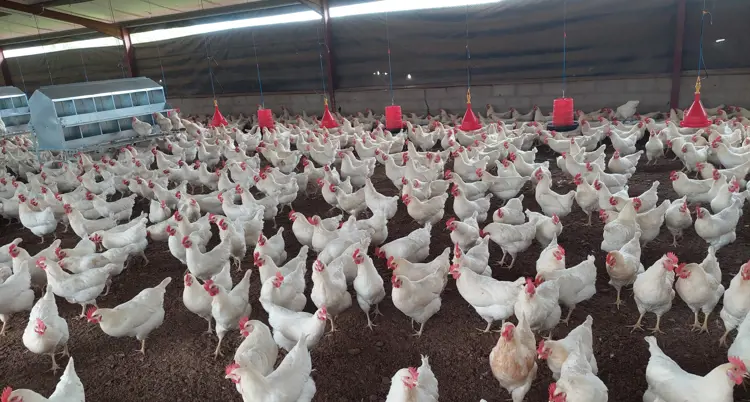Feather pecking in layer chickens: Causes and consequences
Pecking is a natural exploratory behaviour that starts as chickens peck their way out of the egg and learn to forage for food. Chickens will naturally peck at each other out of curiosity and to establish a hierarchy, or “pecking order” among the flock. This can turn into aggressive feather pecking, which can cause feather loss, skin damage, and even death. Feather pecking can become a major welfare problem, particularly in commercial settings, and lead to reduced flock health and productivity.

Causes of feather pecking
- Stress is the most common trigger for aggressive feather pecking. In layers, stress can be caused by several environmental and management factors.
- Heat stress: Excessive heat can cause extreme feather pecking and cannibalism. Temperatures should be measured at bird level and adjusted to a comfortable thermoneutral zone.
- High stocking density: Overcrowding commonly causes aggressive behaviour as dominant chickens will peck at more submissive chickens, fighting for feeder and drinker space and causing high stress levels.
- Excessive light: High light intensity or very long periods of light (> 16 hours a day) outside the recommended breed guidelines can be stressful to chickens, in addition to increasing visibility for aggressive pecking.
- Prolapse or wounds: Chickens are attracted to the colour red, and will instinctively be drawn to the comb, wattles and vent (often reddened after laying an egg). The colour and smell of blood will draw their attention, and untreated wounds can lead to cannibalism. This can be triggered when hens suffer from prolapse or during moulting season, when the curious hens will peck at the newly emerging quills or reddened skin. Cannibalism can become a vicious habit that spreads through the flock.
- Unbalanced ration/Insufficient feed: It is important to differentiate when hens eat the feathers they pluck out due to a deficiency from typical aggressive pecking. If the feathers are being consumed, it can indicate that the layer is not receiving enough protein. While this can be caused by a protein imbalance in the feed ration, it can also occur if the layers aren’t receiving sufficient feed or water to meet their daily intake requirements.
- Other: Abrupt changes to the layers’ routine, loud noises, the introduction of new birds to the flock (mixing ages), pest challenges (especially red mites or vermin), and not removing injured or dead layers in a timely fashion can all contribute to increased feather pecking.
Consequences and prevention
- Increased feed intake: Feather loss causes hens to become colder, especially in severe cases where bald patches have appeared due to feather pecking. To maintain body heat, their feed intake needs to increase to maintain nutrients and energy lost as their bodies work harder to keep them warm. Feed density may need to be adjusted to prevent overconsumption of protein and other nutrients, as well as the mineral imbalances that can follow.
- Welfare is negatively affected by the pain and injuries that feather pecking can cause.
- Cannibalism affects the chicken’s value due to poor feathering and damaged flesh, and consequently decreased production and higher mortalities.
- Economics: All the factors above ultimately have a large impact on the financial bottom line of the farming operation. Higher intakes, more mortalities and lower production all negatively impact the farm’s profitability.
Prevention methods entail minimizing stress factors on the farm by ensuring the correct stocking density, lighting and environmental temperature, isolating injured hens and removing mortalities as soon as possible. Beak-trimming the hens as day-old chicks and matching housing conditions in rearing and laying sheds as far as possible help prevent pecking injuries and stress. Layers should have ad lib access to a well-balanced ration from a reputable feed company.
Conclusion
Stress factors are the major cause of feather pecking, which can spread through a flock and lead to cannibalism, production loss, mortalities and large profit losses. Excellent management is therefore key in preventing feather pecking and all the consequences thereof.
Should you require more information relating to Feather pecking in layer chickens, please contact your nearest De Heus Technical Specialist - https://www.deheus.co.za/meet-our-team/.
